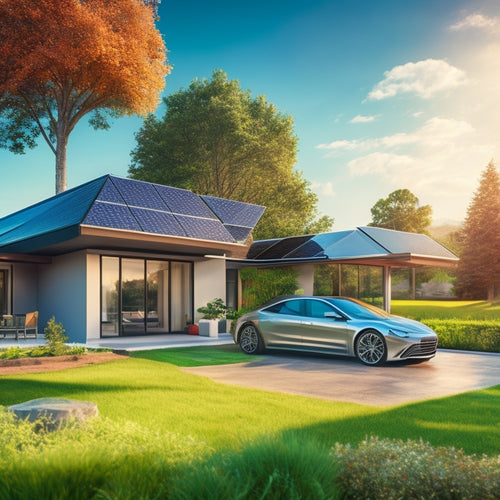
Top Home Solar Battery Storage Systems for Your Home
Share
When selecting a home solar battery storage system, you need to take into account factors like battery life, charging cycles, and energy efficiency to guarantee reliable performance and minimal maintenance. Popular brands like Tesla, LG, and Sonnen offer capacities ranging from 2-13 kWh, with varying levels of efficiency and features. Understanding your energy needs, consumption patterns, and peak usage times is vital to choosing the right system for your home. By evaluating your options based on factors like compatibility, environmental impact, and scalability, you'll be on your way to maximizing your energy independence - and there's more to investigate to find the perfect fit.
Key Takeaways
- Evaluate top brands like Tesla, LG, and Sonnen, considering storage capacity, reliability, and overall value for your energy needs.
- Assess your daily energy requirements in watt-hours (Wh) to determine the appropriate battery size and type for your home.
- Consider factors like compatibility, energy efficiency, and environmental impact when selecting a battery system that meets your needs.
- Lithium-ion batteries are a popular choice due to their high energy density, low self-discharge rate, and longer lifespan (10-15 years).
- Professional installation and regular maintenance are crucial for optimal system performance and longevity of your home solar battery storage system.
Top Battery Storage Systems
As you consider investing in a home solar battery storage system, selecting the right battery storage solution becomes essential. You need a system that meets your energy needs and provides reliable performance.
When evaluating top battery storage systems, you should consider factors such as battery life and charging cycles. Battery life refers to the number of years the battery will last, while charging cycles indicate how many times the battery can be charged and discharged before its capacity degrades.
Look for systems with a long battery life and a high number of charging cycles to guarantee maximum energy storage and minimal maintenance.
Some top battery storage systems include the Tesla Powerwall, LG Chem RESU, and Sonnen eco. These systems offer advanced features such as smart monitoring, automated backup, and grid services.
They also boast impressive specs, including up to 10 years of battery life and over 10,000 charging cycles. By choosing a top battery storage system, you can enjoy a reliable, efficient, and cost-effective energy solution for your home.
Understanding Solar Battery Needs
You need to determine how much energy your home requires to function efficiently, which means identifying your energy requirements and evaluating your power needs.
This involves calculating your daily energy usage in watt-hours (Wh) and understanding your power consumption patterns.
Identifying Energy Requirements
Determining your energy requirements is an essential step in selecting the right home solar battery storage system for your needs. Understanding your energy consumption patterns and peak usage will help you choose a system that meets your specific requirements.
To identify your energy requirements, you'll need to evaluate the following factors:
| Appliance | Power Rating (W) | Daily Usage (h) |
|---|---|---|
| Refrigerator | 150 | 24 |
| Air Conditioner | 900 | 8 |
| Home Office Equipment | 200 | 4 |
| Lighting | 100 | 10 |
Assessing Power Needs
Three key aspects of your energy profile must be evaluated when reviewing power needs for your home solar battery storage system: total daily energy consumption, peak power demand, and backup power requirements.
You'll want to evaluate how much energy your home uses daily, taking into account factors like appliance usage, lighting, and heating/cooling systems.
Peak power demand refers to the highest amount of power your home requires at any given time, typically during morning and evening hours when energy-intensive appliances are in use.
Understanding your energy consumption patterns will help you determine the right battery size and type for your system. A battery that's too small may not meet your power needs, while an oversized battery can reduce its longevity.
You'll also need to review backup power requirements, such as how much energy you'll need during grid outages or at night when the sun isn't shining.
Factors to Consider
When evaluating home solar battery storage systems, an important aspect to examine is the compatibility of the system with your existing solar panel setup and electrical infrastructure.
You'll want to guarantee the system can seamlessly integrate with your current setup to maximize energy efficiency. Additionally, consider the system's capacity to store excess energy generated by your solar panels during the day for use during the night or on cloudy days.
Another significant factor is the system's environmental impact. Look for systems with a low carbon footprint and eco-friendly manufacturing processes. You should also consider the battery's lifespan, recyclability, and disposal methods to minimize waste.
Moreover, evaluate the system's energy efficiency, as some systems may be more efficient than others in converting DC power from your solar panels to AC power for your home.
Lastly, assess the system's monitoring and control capabilities. A good system should provide real-time monitoring, automatic grid switching, and customizable energy management settings to optimize your energy usage.
Popular Home Battery Brands
Your search for the ideal home solar battery storage system likely involves researching popular brands that can meet your energy needs. In this regard, you'll want to evaluate top brands based on their storage capacity, reliability, and overall value.
When it comes to battery brand comparisons, you'll find that companies like Tesla, LG, and Sonnen are often at the top of the list. These brands offer a range of storage capacities, from 2-13 kWh, making them suitable for various home sizes and energy requirements.
For instance, Tesla's Powerwall 2 boasts a 13.5 kWh capacity, while LG's RESU series offers capacities ranging from 3.3-12.8 kWh.
In your evaluation, consider factors like depth of discharge (DOD), round-trip efficiency, and warranty duration. These metrics will give you a better understanding of each brand's performance and reliability.
Additionally, assess the scalability of each system, as this will impact your ability to expand your energy storage capabilities in the future. By carefully evaluating these factors, you'll be able to make an informed decision about the best home solar battery storage system for your needs.
Lithium-Ion Battery Options
Frequently, homeowners opting for home solar battery storage systems find themselves drawn to lithium-ion battery options, which have become increasingly popular in recent years due to their high energy density and relatively low self-discharge rate.
You're likely pondering lithium-ion batteries because of their lithium advantages, including a longer battery lifespan and higher energy efficiency. Lithium-ion batteries typically last between 10 to 15 years, depending on the manufacturer and usage. Their high energy density means they pack more power per unit of weight and volume, making them ideal for home solar battery storage systems.
When choosing a lithium-ion battery, you'll want to contemplate factors like depth of discharge (DOD), cycle life, and warranty.
Look for batteries with a high DOD, as this indicates the battery's ability to supply power without sacrificing its lifespan. Cycle life refers to the number of charge and discharge cycles a battery can handle before its capacity starts to degrade. A longer warranty period typically indicates a manufacturer's confidence in their product's reliability and performance.
Lead-Acid Battery Alternatives
You've examined lithium-ion battery options, but you may be looking for alternatives to lead-acid batteries.
You'll find that nickel-cadmium battery systems offer a different set of characteristics that might better suit your needs.
Sodium-ion battery solutions are another option worth considering, as they're being developed as a potentially more cost-effective and sustainable alternative.
Lithium-Ion Battery Options
The sleek, high-performance electric vehicles that line today's roads owe a considerable debt to the innovative technology of lithium-ion batteries. You're likely familiar with their use in electric vehicles, but did you know they're also an excellent option for home solar battery storage systems? Lithium-ion batteries offer several advantages over lead-acid batteries, including higher battery efficiency, longer lifespan, and faster charging times.
Here's a comparison of lithium-ion batteries with lead-acid batteries:
| Characteristics | Lithium-Ion | Lead-Acid |
|---|---|---|
| Cycle Life | 5,000 - 7,000 cycles | 200 - 500 cycles |
| Efficiency | 95% - 98% | 80% - 90% |
| Self-Discharge | 2% - 3% per month | 5% - 10% per month |
You'll notice that lithium-ion batteries have a considerable longer cycle life, higher efficiency, and lower self-discharge rates compared to lead-acid batteries. These benefits translate to a more reliable and efficient home solar battery storage system, allowing you to maximize your energy harvesting and storage capabilities.
Nickel-Cadmium Battery Systems
Nickel-cadmium (Ni-Cd) battery systems, a popular lead-acid battery alternative, have been widely used in renewable energy systems, including home solar battery storage, for decades.
You may consider Ni-Cd batteries for your solar storage needs due to their nickel cadmium advantages. One significant benefit is their high cycle life, allowing them to withstand deep discharging and recharging without compromising performance. Ni-Cd batteries are also more resistant to extreme temperatures and have a longer lifespan compared to lead-acid batteries. Moreover, they've a lower self-discharge rate, which means they retain their charge longer when not in use.
However, you should also be aware of the nickel cadmium limitations. Ni-Cd batteries contain toxic materials, making them less environmentally friendly. They also have a higher upfront cost compared to lead-acid batteries, although their longer lifespan can offset this expense in the long run.
In addition, Ni-Cd batteries require more maintenance, as they need regular watering and equalization charging to prevent memory effect. By understanding the advantages and limitations of Ni-Cd batteries, you can make an informed decision about whether they're the right choice for your home solar battery storage needs.
Sodium-Ion Battery Solutions
As the demand for sustainable energy solutions continues to grow, sodium-ion battery systems have emerged as a promising lead-acid battery alternative for home solar battery storage.
You're likely considering sodium-ion batteries because they offer several advantages over traditional lead-acid batteries. One significant benefit is improved performance efficiency. Sodium-ion batteries have a higher energy density, allowing them to store more energy per unit of weight and volume. This means you can store more power in a smaller space, making them ideal for homes with limited storage capacity.
Sodium-ion batteries also boast enhanced sodium safety features. They're designed with built-in safety mechanisms to prevent overheating, overcharging, and electrical shorts. This reduces the risk of fire or explosion, giving you peace of mind.
Additionally, sodium-ion batteries are more environmentally friendly than lead-acid batteries, as they don't contain toxic heavy metals. With their improved performance efficiency and enhanced safety features, sodium-ion batteries are an attractive option for homeowners looking for a reliable and sustainable energy storage solution.
Home Solar Battery Costs
Your solar panel system's performance hinges on its battery storage capacity, and understanding the costs involved is essential for a smooth changeover to renewable energy.
As you investigate your options, a cost comparison between different home solar battery storage systems is vital. The upfront cost of a solar battery system can range from $5,000 to $15,000 or more, depending on the type and size of the system.
However, you can offset these costs through various financing options. For instance, you can look into federal and state tax credits, which can cover up to 30% of the total cost.
Additionally, many manufacturers and installers offer financing plans or leasing options to make the changeover more affordable. Some utilities even offer special rates for customers with solar battery systems.
Installation and Maintenance
With your solar battery storage system purchased, it's time to focus on the vital next step: installation and maintenance. You'll want to guarantee your system is installed correctly to maximize energy efficiency and longevity. A professional installation team will assess your home's energy needs and configure the system to enhance performance. They'll also verify all necessary permits and inspections are completed.
Regular maintenance is fundamental to maintaining your system's energy efficiency. You'll need to monitor your system's performance, check for software updates, and perform routine cleaning to guarantee peak energy production.
Additionally, consider scheduling annual inspections to identify potential issues before they become major problems. This proactive approach will help prevent system downtime and extend the life of your solar battery storage system.
As your energy needs evolve, you may need system upgrades to keep pace with your growing demands. A well-maintained system will make it easier to integrate these upgrades, assuring you continue to reap the benefits of renewable energy.
System Comparison and Reviews
When evaluating home solar battery storage systems, comparing different models and reading reviews is essential for finding the best fit for your energy needs. You'll want to take into account factors like battery technology, energy efficiency, and overall performance.
| System Model | Key Features |
|---|---|
| Tesla Powerwall | 13.5 kWh capacity, 92% efficiency, compact design |
| LG Chem RESU | 3.3-12.8 kWh capacity, 95% efficiency, modular design |
| Sonnen eco | 2-16 kWh capacity, 95% efficiency, advanced battery management |
| SimpliPhi Power | 2.7-3.9 kWh capacity, 98% efficiency, modular design |
Frequently Asked Questions
Can I Use a Single Battery for Multiple Solar Panel Systems?
You're probably thinking you can hook up a single battery to multiple solar panel systems and call it a day, but hold up - you'll need to evaluate battery capacity and installation requirements to guarantee a seamless, efficient energy flow.
Do Solar Batteries Work During Power Outages?
When the grid goes down, you'll be prepared: solar batteries work during power outages, providing backup energy and ensuring your home stays lit. By optimizing battery efficiency, you'll maximize outage preparedness and maintain control over your energy needs.
Are Solar Batteries Compatible With Existing Grid-Tie Systems?
You're likely aware that 70% of US homes already have solar panels installed. Now, you're wondering if solar batteries are compatible with existing grid-tie systems. Fortunately, advanced solar battery technology enables seamless grid tie integration, allowing you to upgrade your system without a hitch.
Can I Charge My Electric Vehicle With a Home Solar Battery?
You can charge your electric vehicle with a home solar battery, leveraging its charging capacity and battery efficiency to optimize energy storage and reduce reliance on the grid, while also considering your vehicle's charging requirements.
Are There Any Government Incentives for Solar Battery Systems?
You can take advantage of government incentives for solar battery systems, including federal tax credits worth up to 30% of the system's cost, and state rebates that vary by location, considerably reducing your upfront investment.
Related Posts
-

What Solar Panels Work Best With EVS Online?
When shopping for solar panels online to power your electric vehicle, look for high-efficiency models that can withst...
-

Why Nearby EV Conversion Shops Matter to You
Having a nearby EV conversion shop means you'll experience the benefits of a more personalized, convenient, and susta...
-

Best Solar Panel Options for Maximum Energy Savings
You can maximize your energy savings with solar panels that boast efficiency ratings above 20%, paired with extensive...


